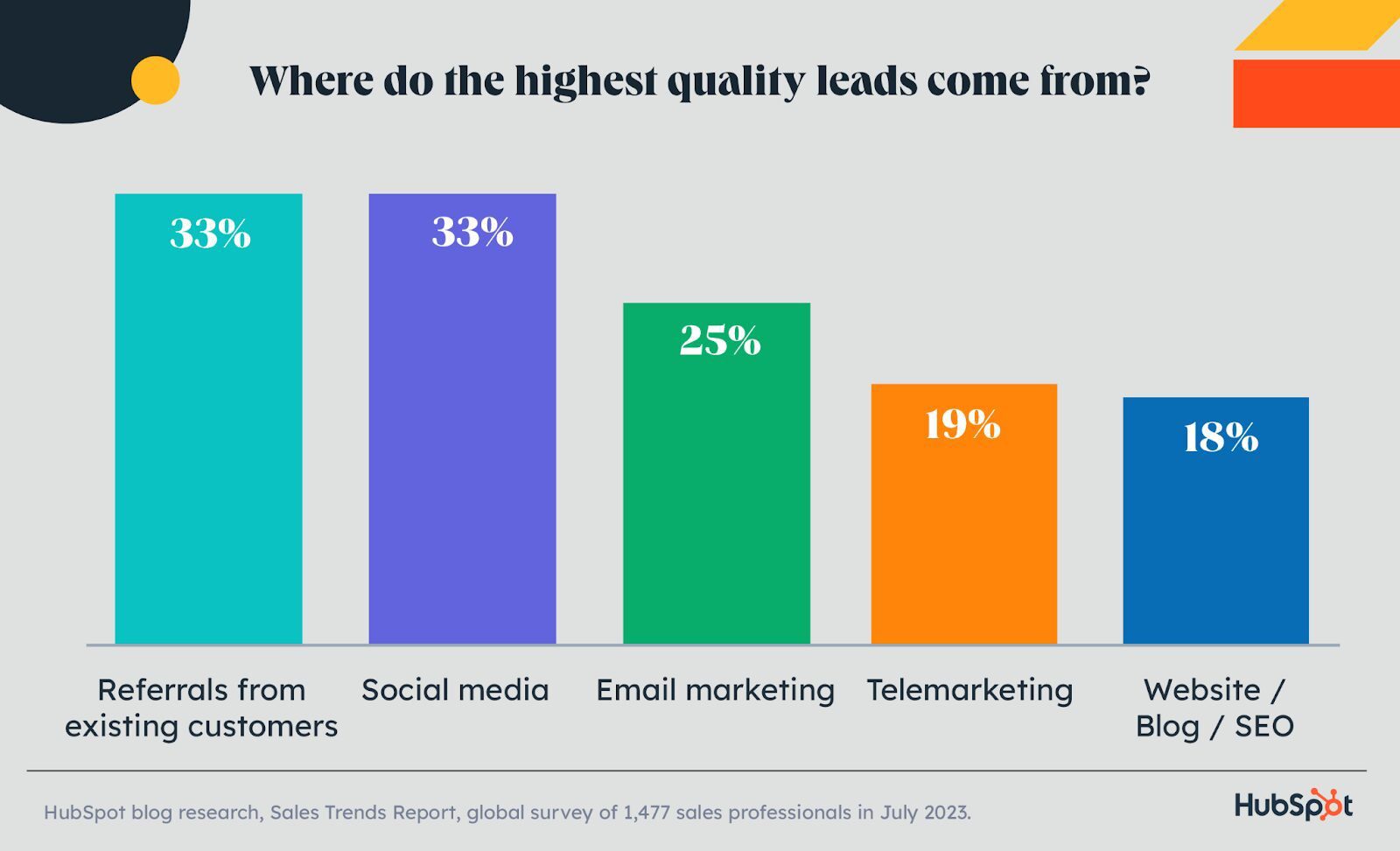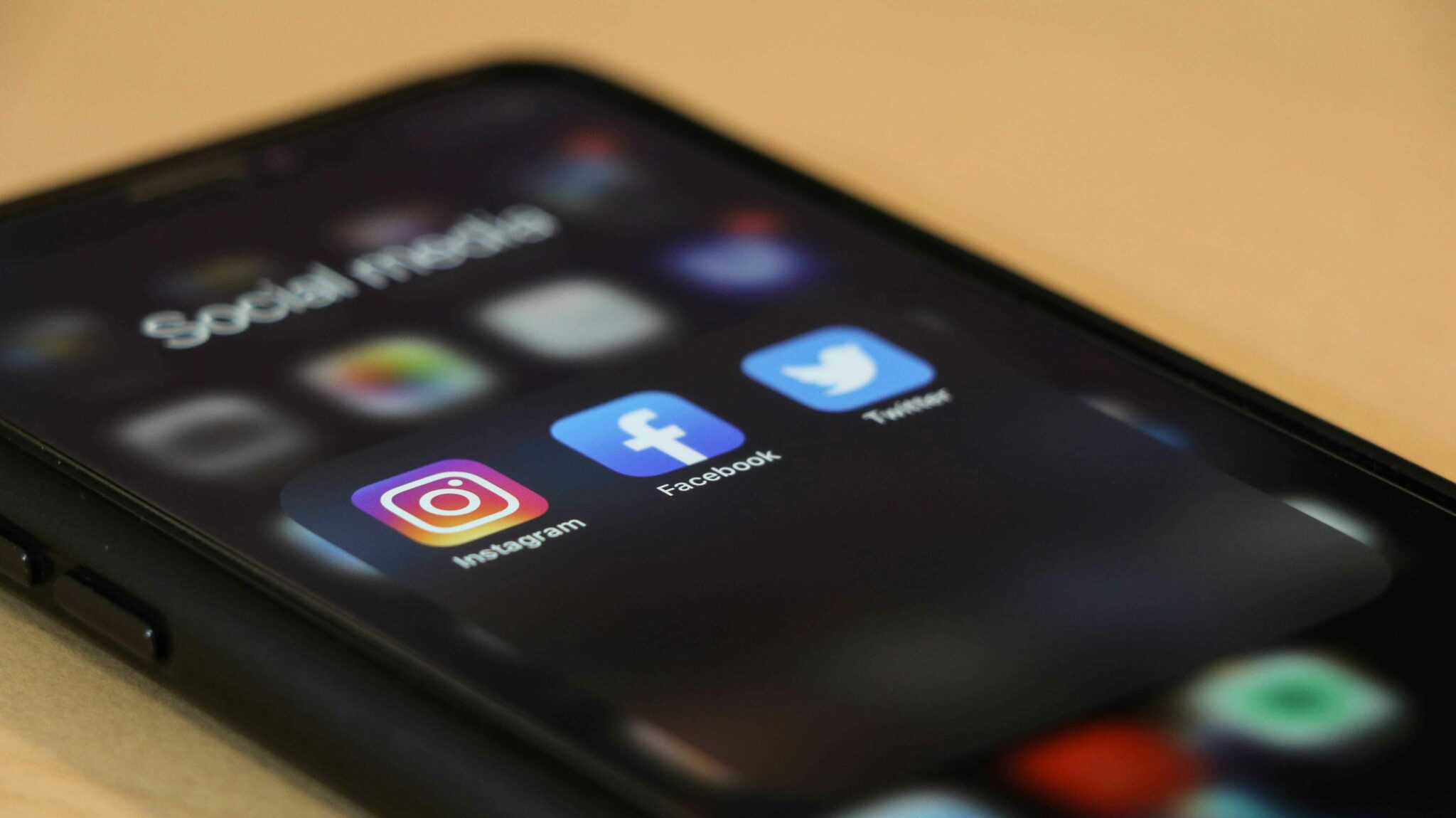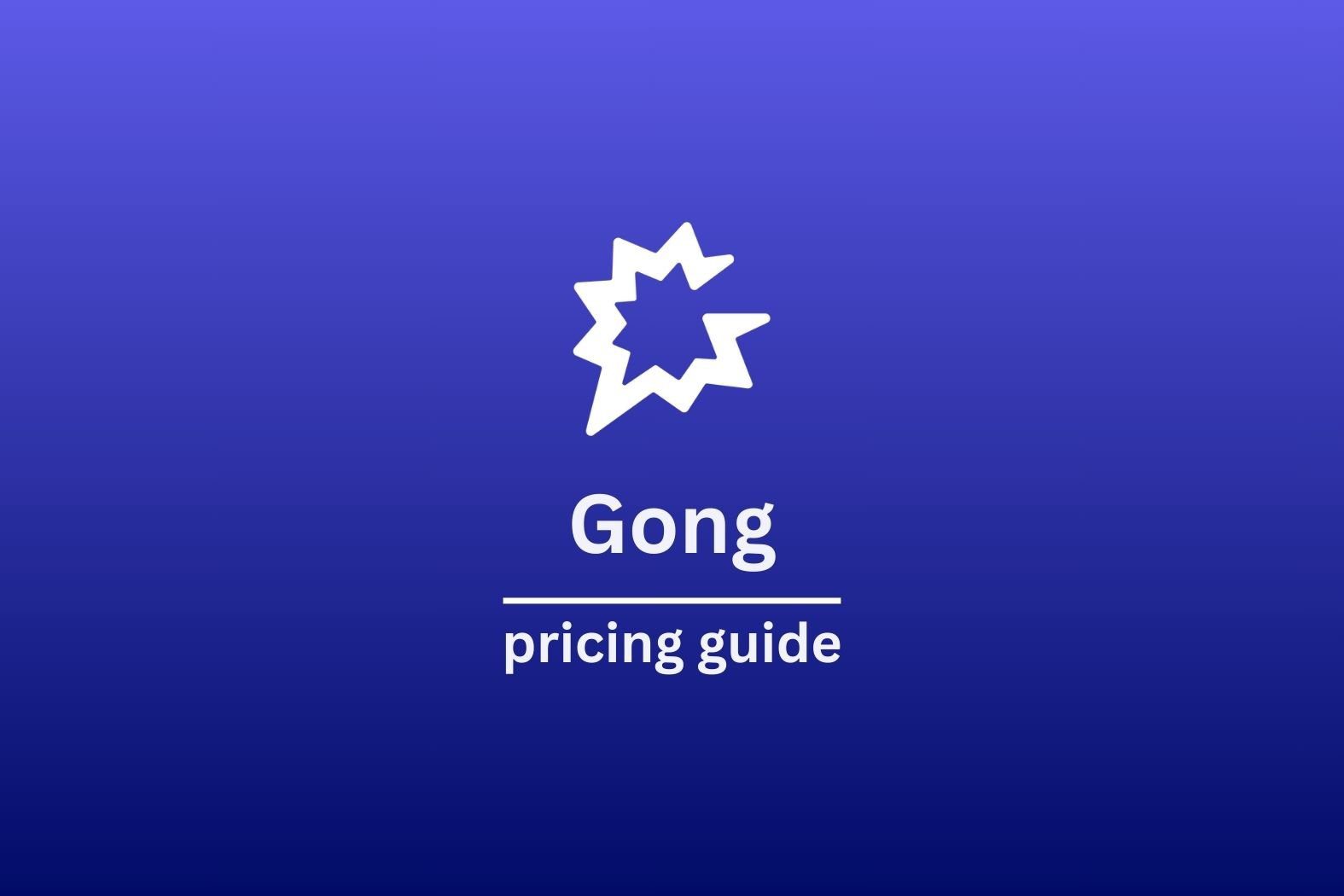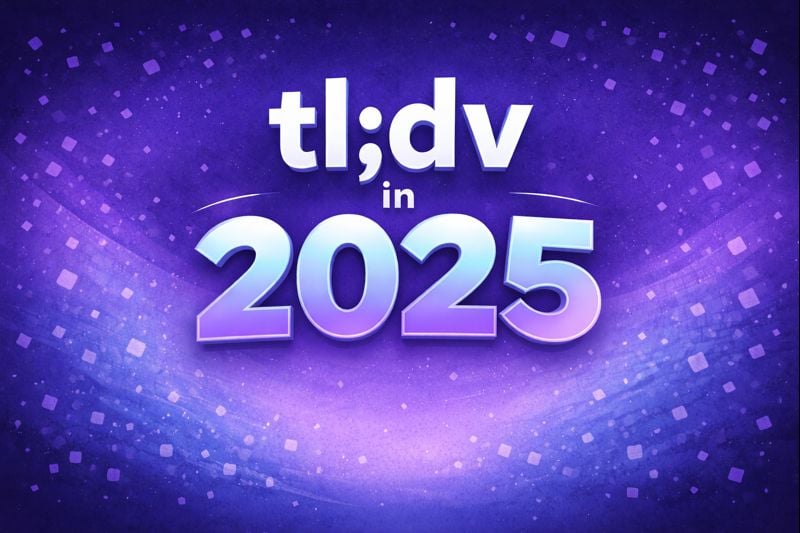La venta social B2B implica el uso de medios sociales como X, LinkedIn o incluso TikTok para conectar con clientes potenciales, construir mejores relaciones y conseguir esa conversión por encima de la línea. En la era digital el 75% de los compradores B2B utilizan las redes sociales para tomar decisiones de compra. Pero no pueden comprar si usted no vende...
Si quieres utilizar la venta social de forma eficaz, tendrás que pensar en términos de blogs, podcasts, vídeos y otros contenidos en línea que posicionen tu marca como la más destacada de tu nicho. El contenido se utiliza mejor para educar y entretener. La idea es captar primero la atención y dejar que el marketing surja de forma natural.
Empecemos por el principio.
¿Qué es la venta social B2B?
La venta social B2B es un método para que los vendedores conecten con clientes potenciales y empiecen a establecer relaciones sólidas a través de las redes sociales. En resumen, permite a las marcas generar confianza, credibilidad y una base más sólida para las asociaciones empresariales.
¿En qué se diferencia la venta social B2B de la venta tradicional?
He aquí un breve resumen de las diferencias entre la venta social B2B y la venta tradicional.
|
Venta B2B tradicional |
Venta social B2B |
|
|
Generación de clientes potenciales |
Se basa principalmente en referencias, llamadas en frío y redes de contactos. |
Utiliza las plataformas de las redes sociales para atraer clientes potenciales naturales. |
|
Alcance inicial |
Suelen iniciarse a través de llamadas en frío o correos electrónicos. |
Comienza con contenidos atractivos, comentarios o solicitudes de conexión en las redes sociales. |
|
Fomento de la confianza |
Depende de las interacciones cara a cara y de las referencias. |
Genera confianza a través de una presencia en línea coherente, liderazgo intelectual y contenidos compartidos. |
|
Credibilidad |
Establecido a través de la reputación de la empresa y el argumento de venta. |
Potenciada por la presencia en línea, las recomendaciones de los compañeros y el intercambio de contenidos. |
|
Desarrollo de relaciones |
A menudo lineal, progresando por etapas en el embudo de ventas. |
Puede ser más orgánico, construyendo relaciones a lo largo del tiempo mediante interacciones continuas en las plataformas sociales. |
Con el auge de Internet y el trabajo en remote , la venta social B2B evoluciona a gran velocidad. Echemos un vistazo más a fondo...
La evolución de la venta social B2B
Antes de Internet, todo el mundo tenía que coger un teléfono o llamar a una puerta para vender su producto o servicio. Ahora puedes generar tus propios anuncios, vídeos y blogs para atraer a clientes potenciales de todo el mundo a través de las redes sociales.
La era de Internet ha colocado la venta social en un pedestal. La definición de venta social solía consistir principalmente en establecer una relación de confianza con la clientela potencial. Ahora se trata de utilizar TikTok o Instagram para subir contenidos breves y vender algo indirectamente. Una genialidad. También puedes saltarte la llamada en frío, optar por no enviar un correo electrónico al cliente potencial y, en su lugar, enviar un mensaje directo a alguien en Linkedin.
Pero ya hemos superado la era de Internet. La Web 3.0 está en el horizonte y la pandemia ha acelerado sin duda la dependencia mundial de las herramientas digitales. Esta es la era en la que la venta social B2B está cobrando todo su sentido, no sólo como un gran método de ventas, sino posiblemente como el futuro de las ventas. Gartner predice que para el año que viene (2025), el 80% de las interacciones de ventas B2B tendrán lugar a través de canales digitales.
Ya sea navegando por LinkedIn, utilizando una aplicación móvil de su CRM o implementando herramientas de automatización de IA para rastrear los patrones de comportamiento de un comprador, la era remote-first está sobre nosotros y la venta social B2B está prosperando.
Optimizar la generación de prospectos con las redes sociales
Los estudios demuestran que 78% de los vendedores que participan en la venta social superan a sus compañeros que no utilizan las redes sociales. Si aún no has empezado con la venta social B2B, ahora es el momento...
Las redes sociales se han convertido en un poderoso recurso para que las empresas y las marcas generen clientes potenciales y amplíen su base de clientes. Mediante promociones de pago o interacciones auténticas, se pueden aprovechar las plataformas de las redes sociales para conectar con un público nuevo y transformarlo en clientes fieles. Hoy en día, la venta social ha cambiado la forma en que las empresas venden a otras empresas, lo que las convierte en cruciales para las empresas que desean seguir siendo competitivas. El ejemplo más vívido puede servir a la empresa Epom, que utiliza con éxito y se beneficia de las técnicas de venta social durante muchos años de actividad de la empresa, afirma Lina Lugova, CMO de Epom.
El 75% de los representantes de ventas utilizan Facebook para encontrar clientes potencialesseguido de Instagram, Linkedin y YouTube. Puede sonar extraño, pero aquí es donde están los compradores. De hecho, las redes sociales son, junto con las referencias, las primeras en generar clientes potenciales de mayor calidad para su negocio.

Las redes sociales revolucionan la captación de clientes potenciales, ya que permiten dirigirse a un público específico en función de sus características demográficas, intereses, gustos y hábitos en Internet. LinkedIn y Facebook ofrecen desgloses de audiencia avanzados, que le ayudan a dirigirse a grupos demográficos de clientes específicos y a aquellos que tienen más probabilidades de estar interesados en su producto o servicio. Esto le ayudará a refinar los clientes potenciales y hacerlos más adecuados, lo que debería conducir a un aumento de las tasas de conversión.
Contenidos atractivos para generar clientes potenciales
A todos nos gusta una buena historia que nos enganche, ya sea un libro, un programa de televisión o una película. Generar clientes potenciales a través de las redes sociales no es diferente. Ahora nos desplazamos a través de nuestros teléfonos de forma regular y así es como las empresas te enganchan, a través de influencers B2B y vídeos que te dan ganas de comprar algo.
Para sacar el máximo partido de la venta social B2B, lo primero y más importante es entender a tu público. Una vez delimitado el mercado objetivo, hay que atender sus necesidades y crear contenidos que les gusten. Esto también implica establecer pilares de contenido que resuenen con sus intereses y desafíos.
Lo ideal es que les eduques sobre sus puntos débiles, ofreciéndoles contenido valioso que haga que tu público objetivo vuelva. Se identificarán con los problemas de los que hablas y empezarán a ver tu marca como un recurso valioso, además de una fuente de entretenimiento. Recuerde: la mayoría de la gente se desplaza por las redes sociales para descansar del trabajo, por lo que no debe ser exagerado en la forma de intentar vender. La clave es construir una presencia y establecerse como una autoridad.
Un estudio de caso: ¡US!
Como ejemplo, echa un vistazo a nuestra grabadora de reuniones para grabar una partida de Dragones y Mazmorras...
@tldv.io Respondiendo a @timeguy0 ¿Queréis LARP? #dungeonsanddragons #productmanagement #techstartup #aitools #customersuccess #corproratehumour
♬ sonido original - tldv.io - AI Meeting Recorder
No tenía nada que ver con el trabajo o los negocios, pero la gente lo pedía. Fue por diversión. Porque por eso la gente entra en TikTok.
Puede que no parezca un método de marketing obvio, pero se sorprendería. En al menos un tercio de todas nuestras llamadas con clientes potenciales se hace referencia a nuestros canales sociales y, cuando se les pregunta, más del 50 % de los clientes potenciales dicen que nos encontraron a través de nuestros canales sociales.
"Nuestros vídeos de TikTok o Instagram aparecen en casi todos los primeros correos que recibimos. Ayuda a romper el hielo y te da una ventaja sobre otros productos de tu nicho que es difícil de replicar."
Pedro Marzagão, Jefe de Marketing de tl;dv Tweet
Pero no se puede entrar así como así. Siempre se necesita una estrategia.
Optimización, seguimiento y análisis
Optimice su contenido; asegúrese de que está en primera línea de las plataformas y motores de búsqueda más populares para atraer el mejor tipo de tráfico. Utilice palabras clave y metaetiquetas relevantes, y proporcione contenido de alta calidad para dar valor real a su audiencia. Está muy bien crear contenidos atractivos, pero si nadie los ve, tienes un problema.
A partir de aquí, puedes relacionarte orgánicamente con los clientes potenciales. Responde a sus comentarios en las publicaciones, mantén conversaciones en los blogs y hazte una mejor idea del tipo de persona con la que estás tratando y qué tipo de relación puedes construir. El 31% de los profesionales B2B creen que han construido relaciones más fuertes con los clientes a través de la venta social B2B. Una vez que empiezas, ¡es fácil ver por qué!
Si haces un seguimiento del contenido que publicas utilizando herramientas analíticas, podrás descifrar qué resuena en tus clientes potenciales y qué no. Pruebe diferentes campañas, modifique su estrategia y vuelva a intentarlo. Cuanto más pruebe, más aprenderá.
También es el momento de agilizar los flujos de trabajo mediante la automatización de los procesos de venta. Existen multitud de herramientas que pueden hacer el trabajo pesado en lo que respecta a la optimización, el seguimiento y el análisis. Usted sólo tiene que configurar las integraciones e introducir los datos en la herramienta elegida; ellos hacen el resto y los presentan de forma que le faciliten la vida. Basta con ver cómo se puede utilizar GPT para las ventas y aplicarlo a las ventas sociales B2B. Es facilísimo.
Crear y mantener el compromiso a través de las plataformas sociales
Crear y mantener el compromiso en las redes sociales es otro proceso importante de la venta social B2B. La clave está en conectar con la audiencia, compartir contenidos con regularidad y responder rápidamente a los comentarios y preguntas de los seguidores.
Si mantienes conversaciones genuinas con clientes potenciales, fortalecerás las relaciones y sentarás las bases de una base leal de seguidores. El 76% de los consumidores han comprado un producto que vieron en una publicación de una marca en las redes sociales. Este es uno de los mejores procesos de venta que puedas imaginar para impulsar las ventas en la era moderna. Para gestionar eficazmente tu presencia en Internet, considera la posibilidad de utilizar herramientas que te permitan programar las publicaciones en las redes sociales, garantizando un compromiso constante y puntual con tu audiencia.
Para crear y mantener el compromiso a través de las redes sociales, hay que captar al cliente con cuatro puntos clave:
- Haga que su contenido sea relevante. Asegúrese de que su contenido coincide con las últimas tendencias y con lo que realmente le interesa a su público. Tienes que entender qué interesa a tus clientes potenciales y apelar a ello.
- Aporte valor. Si su contenido ofrece algo valioso, atraerá al cliente. Puede ser información, consejos y trucos, o alguna forma de entretenimiento. Haz que se pueda volver a ver, que se pueda compartir y asegúrate de que tu cliente se vaya con tu producto en la cabeza.
- Fomentar la participación. Si fomentas la participación, como comentarios, me gusta y compartir, seguirás siendo relevante y dando que hablar.
- Mantén la coherencia. Mantenga un calendario regular de publicaciones para no perder de vista a su público. La constancia generará confianza y mantendrá un alto nivel de compromiso con su producto.
Utilizar varios canales de medios sociales
Hay varios canales de medios sociales para utilizar en los diferentes procesos de venta social B2B. Estos son algunos...
Puedes utilizar Facebook para ponerte en contacto con posibles clientes potenciales, delimitar tus criterios y tu base de datos y entablar conversaciones con ellos. Es una buena idea crear una página de Facebook e interactuar con tus seguidores y con otras empresas hasta que se te pongan los pelos de punta.
X (Twitter)
X, antes conocida como Twitter, es una fantástica plataforma de venta social B2B que puede ofrecerte interacción en tiempo real con posibles clientes y mantenerte al día de las últimas noticias y tendencias de marketing. Es fantástico encontrar noticias relacionadas con el sector mediante la búsqueda de un hashtag y puedes crear entradas de blog y anuncios sobre tu producto que atraigan las interacciones.
En concreto, puedes crear listas de Twitter para vigilar contenidos específicos de distintos grupos. Vigila a la competencia, haz una lista de posibles clientes potenciales y echa un vistazo a la actividad de tus clientes actuales para ver si puedes obtener información valiosa que mejore tus procesos de venta.
LinkedIn es más una plataforma comercial formal que le ayuda a identificar y contactar con empresas y sus responsables para establecer una relación de trabajo profesional. Sin embargo, LinkedIn está experimentando con contenidos de vídeo de corta duración y está preparada para convertirse en el lugar ideal para la venta social B2B.
Es un lugar estupendo para compartir, por ejemplo, utilizando las herramientas de programación de LinkedIn, pero también para obtener información sobre el sector de los líderes y casos prácticos específicos. A través de LinkedIn Sales Nav puedes llegar de forma específica y personalizar tu mensaje para ayudar a generar los mejores contactos y clientes potenciales. Es ideal para establecer contactos en el mundo B2B.
TikTok
Especializada en vídeos cortos, TikTok es una plataforma de redes sociales relativamente nueva que utilizan sobre todo los jóvenes. Esta base de usuarios no aprecia la venta directa y rápidamente pasa por alto los anuncios o las publicaciones patrocinadas. Sin embargo, sí aprecian los contenidos divertidos o graciosos. La venta social a través de TikTok puede ser un reto si no conoces tu mercado objetivo, pero muy gratificante si lo conoces.
Instagram es un paraíso de venta social B2B para las empresas. Tiene casi dos mil millones de usuarios activos mensuales, lo que lo convierte en el lugar perfecto para mostrar tu producto o servicio. A la gente le encanta comprar, seguir a las empresas e interactuar con las marcas directamente, a través de los pies de foto, comentarios, hashtags y publicaciones de Instagram. Además, puedes mejorar la presencia de tu cuenta de Instagramcon herramientas como Getlikes para escribir pies de foto atractivos para tus publicaciones en las redes sociales.
Consulte las estadísticas de participación empresarial que figuran a continuación y pregúntese si quiere perderse esta riqueza de clientes potenciales...

Convertir el compromiso social en ventas B2B
Participar en las redes sociales es imprescindible si quieres atraer la atención y el interés adecuados en torno a tu producto. Ofrezca contenidos de alta calidad en plataformas como TikTok e Instagram que le hagan hablar con la gente. A continuación, haz magia y conviértelos en clientes de pago.
El verdadero reto consiste en convertir esos "me gusta" y esas interacciones en dólares. La mejor manera de hacerlo es dejar que tu mensaje se escuche en el contenido que estás publicando. Muestra tu marca al mundo con autenticidad. No intentes vender directamente, simplemente conviértete en una voz líder para tu mercado. El truco está en conseguir que los clientes acudan a ti.
El compromiso es una cosa, pero es importante utilizar una llamada a la acción en su estrategia de venta social B2B. Cuando captas la atención de tu cliente potencial a través de un mensaje directo, un formulario de registro o una página de destino, puedes proporcionarle una idea clara de los pasos siguientes en caso de que desee continuar con la compra. Esto aumenta sus posibilidades de convertir seguidores en clientes potenciales.
Fidelización de clientes potenciales y mensajes directos
Cuando se está a punto de convertir seguidores en clientes potenciales, es importante nutrirlos a lo largo de todo el proceso y mostrarles cómo va a ser el recorrido del comprador.
Lo que no hay que hacer es calentar al cliente potencial y luego dejarle que encuentre su propio camino. La clave está en dirigirlos al lugar y a las personas adecuadas para impulsar la conversión. Es mucho más probable que un cliente potencial se registre si cree que el proceso es muy sencillo y requiere muy poco esfuerzo por su parte.
Una forma de hacerlo es formar a tu equipo de redes sociales en el arte de las ventas, o viceversa. Cuanta más libertad tengan los vendedores sociales, más clientes potenciales podrán atraer. Después de todo, es probable que el cliente potencial se sienta cómodo con el vendedor social. Que de repente se vea empujado hacia otra persona puede causar fricciones, aunque no es el fin del mundo siempre que el proceso sea fluido.
El proceso iterativo de la venta social
En pocas palabras, la venta social B2B es un proceso iterativo con varios pasos clave. Desde la participación en las redes sociales hasta la consecución de la conversión, echemos un vistazo a los doce puntos clave del ciclo de ventas:
- Escuche y aprenda. Preste mucha atención a lo que dicen sus seguidores (y competidores) en las redes sociales. Esto puede servirte para ajustar tu estrategia.
- Construye tu marca. Proporciona mucha información valiosa a través de contenidos para demostrar a la gente que sabes de lo que hablas y que por eso deberían escucharte.
- Hable con la gente. Interactúe con su mercado objetivo compartiendo y comentando las publicaciones.
- Sé útil. Apoya y educa a la gente siempre que puedas.
- Encuentra a gente interesada. Averigua quién está interesado y quién no.
- Aporte soluciones. Construya su contenido en torno a la solución de los problemas específicos de sus principales clientes potenciales.
- Haga una venta. Cuando un cliente potencial muestre un interés significativo, póngase en contacto con él y vea si puede llegar a un acuerdo.
- Solicite opiniones. Pida opiniones concretas sobre lo que puede mejorarse y lo que funciona.
- Cree seguidores. Haz que tus clientes corran la voz y creen seguidores y fans de tu producto.
- Siga aprendiendo. Manténgase al tanto de las tendencias del mercado y de las opiniones de los clientes. Hay que cambiar las cosas cuando sea necesario.
- Analice y ajuste. Revise periódicamente lo que le funciona y lo que no. Tienes que hacer cambios específicos basados en estos enfoques y en lo que has aprendido.
- Mejora tu estrategia. Utiliza los comentarios que recibas para ajustar tus tácticas y hacerlas más eficaces. Asegúrate de establecer objetivos de mejora y haz un seguimiento de tus progresos a lo largo del tiempo.
Medir el impacto de la venta social en las ventas B2B
Siga estos KPI cruciales para realizar un seguimiento de su progresión mientras aprovecha la venta social B2B.
- Tasa de participación. Realiza un seguimiento de la participación general de todos tus contenidos. Mide los likes, comentarios, shares, clics y visualizaciones de toda tu audiencia.
- Porcentaje de clics. El CTR mide cuántas personas de toda la plataforma han hecho clic en tu página o en un enlace de tu historia, en comparación con cuántas personas han visto tu contenido. Un CTR alto es tu objetivo, ya que demuestra que tu contenido es atractivo y atrae tráfico a tu página. Vigílalo para saber cuándo tu llamada a la acción necesita más trabajo.
- Tasa de conversión. Tu tasa de conversión es tu mayor indicador para determinar si tu contenido tiene éxito. La tasa de RC mide el porcentaje de personas que pasan de ser seguidores a clientes tras interactuar contigo en una plataforma social.
- Clientes potenciales generados. Otra métrica que te ayudará a determinar si tu estrategia es eficaz es medir el número de clientes potenciales que has captado gracias a la venta social.
- Rendimiento de los contenidos. Diseccione su contenido y analice su eficacia a la hora de contribuir a los esfuerzos de venta. Mide el CTR, el tiempo de visualización y las métricas de participación de tu publicación y modifica tus estrategias en función de las lecturas.
Mediante el seguimiento de estos indicadores de rendimiento, puede ajustar su estrategia cuando sea necesario y realizar un seguimiento preciso de su éxito. Esto es fundamental para el éxito de una campaña en las redes sociales.
Venta social: El futuro de las ventas
La venta social existe desde hace algunos años, normalmente como una forma de hablar sobre la creación de relaciones en línea. Sin embargo, la venta social B2B ha avanzado hacia una nueva era con el auge del marketing digital. Cuando se aprovecha bien, convierte a los seguidores fieles en clientes fieles.
Se espera que el "marketing de contenidos" y las "redes sociales" sean los canales de venta más importantes en los próximos años, adoptados por el el 42,1% y el 68,4% de las empresas. Está claro que la venta social B2B no va a ralentizarse pronto, así que ¿a qué esperas?





